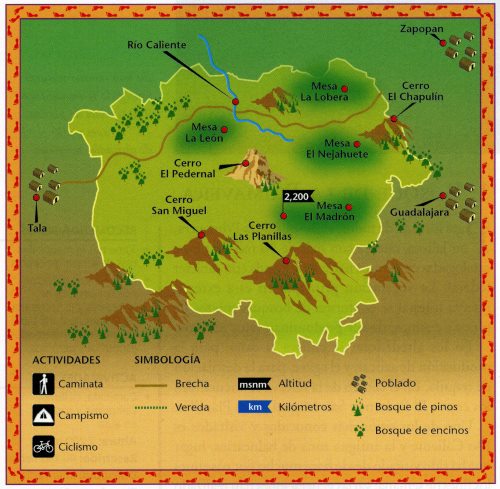A 1988 Management plan for the Primavera Forest (Plan de Manejo Bosque La Primavera), published by the University of Guadalajara, included a detailed list of the then-existing pressures on the forest.
Sadly, not much has changed since then, and almost all the sources of pressure mentioned in that study still apply today.
The management plan argues that the key areas (see map) where careful management is essential include:
- Cerro San Miguel and Cerro Las Planillas, the highest elevations in the area
- The environs of the tourist spa of Río Caliente (this spa is now closed)
- Mesa de Nejahuete, in the center of the volcanic caldera, and
- Mesa del León, considered an important habitat, primarily for fauna
The plan identifies the following sources of concern (note that this list is in no particular order, and certainly not in order of highest pressure to lowest):
1. Tourism. Poorly planned recreation areas, such as autodromes and spas. Issues resulting from this source of concern include pollution, waste disposal, soil erosion, landscape degradation, habitat change, reduced fauna and, switching to a human focus, delinquency. Motorcycles and trail bikes are a particular problem because of the associated noise pollution, annoyance and risk to other visitors, habitat destruction, the displacement of fauna and often lead to accelerated soil erosion.
2. Ejidos. Any expansion of neighboring ejidos means more homes, deforestation and landscape alteration.
3. Quarrying. The quarrying of local rocks such as pumice or river deposits, as well as a number of abandoned quarries can result in habitat destruction, erosion, forest degradation, accelerated mass movements (landslides, rockfalls), posing a risk to infrastructure, access routes and the potential pollution of ground water.
4. Hunting. Hunters leave spent cartridges that can pollute the soil, as well as wounded and abandoned animals. Larger fauna have become progressively more scarce. In addition, the presence of individuals carrying firearms poses a security threat.
5. Cultivation and Overgrazing. Increased cultivation (primarily for sugar cane, corn and beans) has gradually nibbled away at the edges of the forest, with the clearance method of slash and burn being a particular problem since it greatly raises the risk of wildfires, soil degradation and deforestation. As the number of access routes increases, it is easier for local farmers to graze livestock in the forest, reducing the health of the grassland, and leading to a relative abundance of unwanted plants and weeds, accelerated soil erosion and the possible contamination of water sources.
6. Deforestation. Deforestation is also a pressure on the forest, in which the cutting of woodland for fuel (including bonfires) and for firebreaks, leads to changes in habitat and soil use, with the secondary effects of increased erosion, reduced ground water recharge and varying degrees of secondary forest succession.
7. Geothermal Power. The potential development of some areas for geothermal power by the Federal Electricity Commission (CFE) has already involved the opening of access routes and would lead to noise contamination (with adverse effects on fauna) and possible pollution of ground water, air and soil, as well as deforested hillsides. The loss of vegetation cover would trigger accelerated erosion, and habitat destruction, further reducing water quality. Access routes attract other “users” such as those seeking to quarry local rocks or clear land for farming.
8. Settlements. Settlements and subdivisions have also encroached on the forest. Some are irregular/illegal settlements, but others are private homes and clubs. Regardless of economic level, these settlements result in a decrease in vegetation and the elimination of the soil’s litter layer, leading to soil compaction, lowered infiltration rates, and nutrient-depleted soils, as well as increased pollution and the gradual elimination of native fauna
9 Wildfires. Wildfires, such as that in 2012, destroy vegetation and cause a general degradation of the woodland. They can result in the accelerated degradation of soil, water and vegetation, leading to significant changes to soil structure, as well as increased runoff and reduced groundwater recharge.
10. Inadequate regulations. The problems faced by the Primavera Forest are compounded because the relevant local authorities have shown little interest in ensuring adequate regulations, supervision and enforcement.
Many of these ten major pressures are closely interrelated. Despite the good intentions back in 1988, it is clear now, with the benefit of hindsight, that the 1988 management plan did not achieve very much. Hopefully, in the not too distant future, and as the Primavera Forest gains international status as a possible Geo-Park, a more comprehensive and effective management plan can be devised and implemented.
Related posts

Sorry, the comment form is closed at this time.